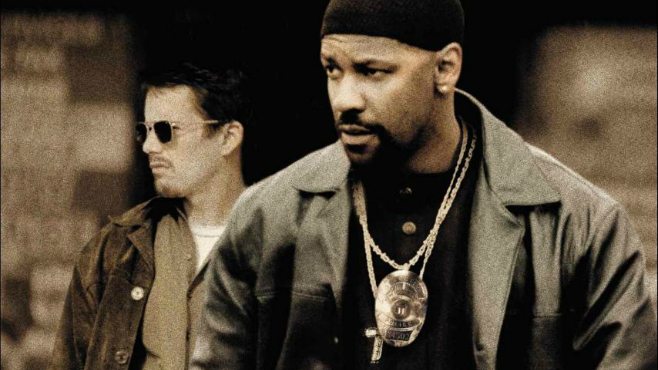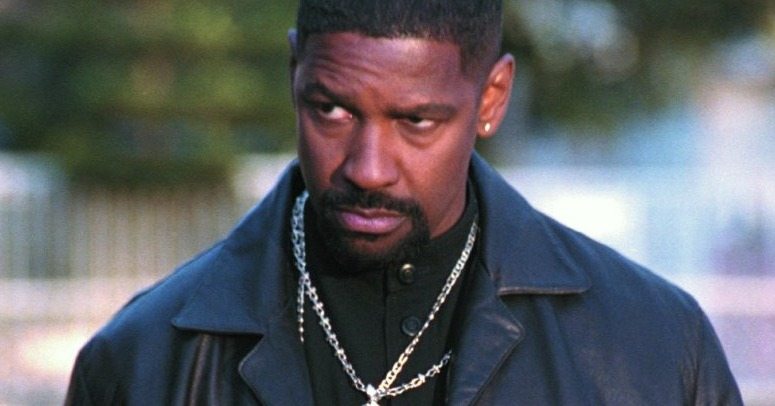A gripping and intense crime drama, ‘Training Day’ takes us into an undercover police operation with dubious moral grounds. The film follows Detective Sergeant Alonzo Harris (Denzel Washington), a charismatic narcotics officer who has questionable work ethics. An idealistic officer-in-training, Jake Hoyt (Ethan Hawke) partners with Harris as he learns more about the dangerous street life of Los Angeles. In the course of 24 hours, Hoyt learns things the hard way — he comes face to face with Harris’ schemes and finds himself amidst situations that can put his life in danger. Written by David Ayer and directed by Antoine Fuqua, the film is an intense drama that stands out in its genre. Let us have a closer look at the film’s narrative and uncover the subtle details. SPOILERS AHEAD.
Training Day Plot Synopsis
LAPD officer Jake Hoyt is teamed with Detective Alonzo Harris, a decorated narcotics officer. Harris and Hoyt start their day by catching teenagers for possessing cannabis. Harris forces Hoyt to consume the drug, saying that refusing to take drugs on the street could get him killed. Hoyt reluctantly abides by Harris. Hoyt and Harris go to Roger, a cop-turned drug dealer, and after their visit, Hoyt prevents a sexual assault on a woman.

Subsequently, Harris, using a fake search warrant, steals $40,000 from Kevin “Sandman” Miller, a drug dealer. He then visits his mistress, Sara, and his son. It is revealed that the Russian mafia is on the lookout for Harris, who is advised to skip town. However, Harris trades the money he stole from Sandman in exchange for an arrest warrant. Using the warrant, Harris, Hoyt, and four other officers invade Roger’s house and seize $4 million. Hoyt is disturbed by the dubious ways and stands up against his seniors but is trapped by their machinations.
Harris then takes Hoyt to Smiley, a member of the Hillside Trece street gang. The corrupt officer abandons Hoyt and has apparently paid Smiley to kill his trainee. Smiley realizes that Hoyt had saved his cousin from a brutal assault (the girl he saves in the alley) and decides to let him go. Meanwhile, Harris has to pay $1 million to the Russian mafia since he had killed one of their men. Hoyt goes to confront Harris in Sara’s apartment. The ensuing confrontation between the two cops turns ugly as it becomes a battle between the upright and the corrupt.
Training Day Ending: What Happens to Alonzo Harris?
In the end, Hoyt confronts Alonzo Harris for his wrongdoings. He is disturbed by his corrupt ways and witnesses the extent to which it has infiltrated the police force. He attacks Harris but is overpowered, and Harris tries to escape. In the ensuing chase, Hoyt is able to stop his senior and takes his money and badge. Even though Harris tries to kill him, Hoyt doesn’t retaliate the same way. He decides to use the money as a witness to put an end to Harris’ corrupt ways.

Harris knows the street gang very well. When cornered, he offers money to the neighborhood that is watching the showdown. But none of them comes to take the prize money. This scene makes it clear that the street gangs do not approve of Harris’ scheming ways. The gang members dislike his methods, and they seem to relish Harris’ predicament. Moreover, they allow Hoyt to walk away.
Even in the face of a dire situation, Harris threatens the people — it signifies that he is engulfed by his lust for power and has seemingly forgotten the softer methods of a bargain. The Russian mafia eventually kills Harris for his indiscretion and the failure to pay the compensation money. It is a cathartic ending that allows Hoyt to redeem himself for his partaking in unethical methods.
Essentially a showdown between the two cops’ moral beliefs, the climactic act takes us through the repercussions of corruption. However charismatic Harris may seem, his approach doesn’t justify his quest for street justice. A clever narrative device that declares the victory of uprightness over corruption is the depiction of Harris’ death in the news. It plays out in the same way as Harris predicts for Hoyt in one of the earlier scenes. In essence, Harris actually falls victim to his own machinations and unquenchable desires. Once caught in the quagmire of corruption, it is very difficult to redeem oneself, which can even lead to death.
Why Does Harris Abandon Hoyt in Smiley’s Home?
Harris is supposed to usher Hoyt into the urban nightmare of Los Angeles. The situation is also driven by Hoyt’s ambition to become a narcotics officer and catapult himself to a higher position. However, his ambitions take a dark turn as he is caught in the plans of Harris. Things start to become clear when Harris reveals that the cannabis Hoyt smoked was laden with PCP, a strong psychotropic drug. Harris had actually drugged Hoyt on gunpoint. When they reach Roger’s home a second time, Hoyt takes the first step in the defiance of Harris’ schemes. After the standoff, it becomes clear to Hoyt that Harris has his own ulterior motives, disguised in the garb of a training day.

While in Smiley’s home, Harris abandons Hoyt as he has efficiently used his service to acquire the money to pay off the Russian mafia. Hoyt is supposed to be eliminated, but his act of upholding justice while saving a woman from marauding criminals helps him survive Smiley’s and his crew’s attack. In essence, through this act, the film exhorts that an upright act will positively affect the person. The scene in Smiley’s home is the exposition of Harris’ intention in using Hoyt as a pawn in his larger game. Harris perhaps needs an unassuming person like Hoyt to plan his actions without any collateral damage.
It is a realization that they both need each other to fulfill their own desires situated on the opposite sides of a spectrum. Director Antoine Fuqua has a strong grip on this aspect as he carefully creates the moment that actually positions the two lead characters in stark contrast. For example, in the stand-off scene, Hoyt is captured on a high-angle shot, whereas Harris is depicted from a low angle. The mise-en-scene has a sharp verve that brings out both the characters’ intention, with Hoyt presented as the representation of justice and Harris being the symbol of anarchy.
Read More: Is Training Day Based on a True Story?


You must be logged in to post a comment.